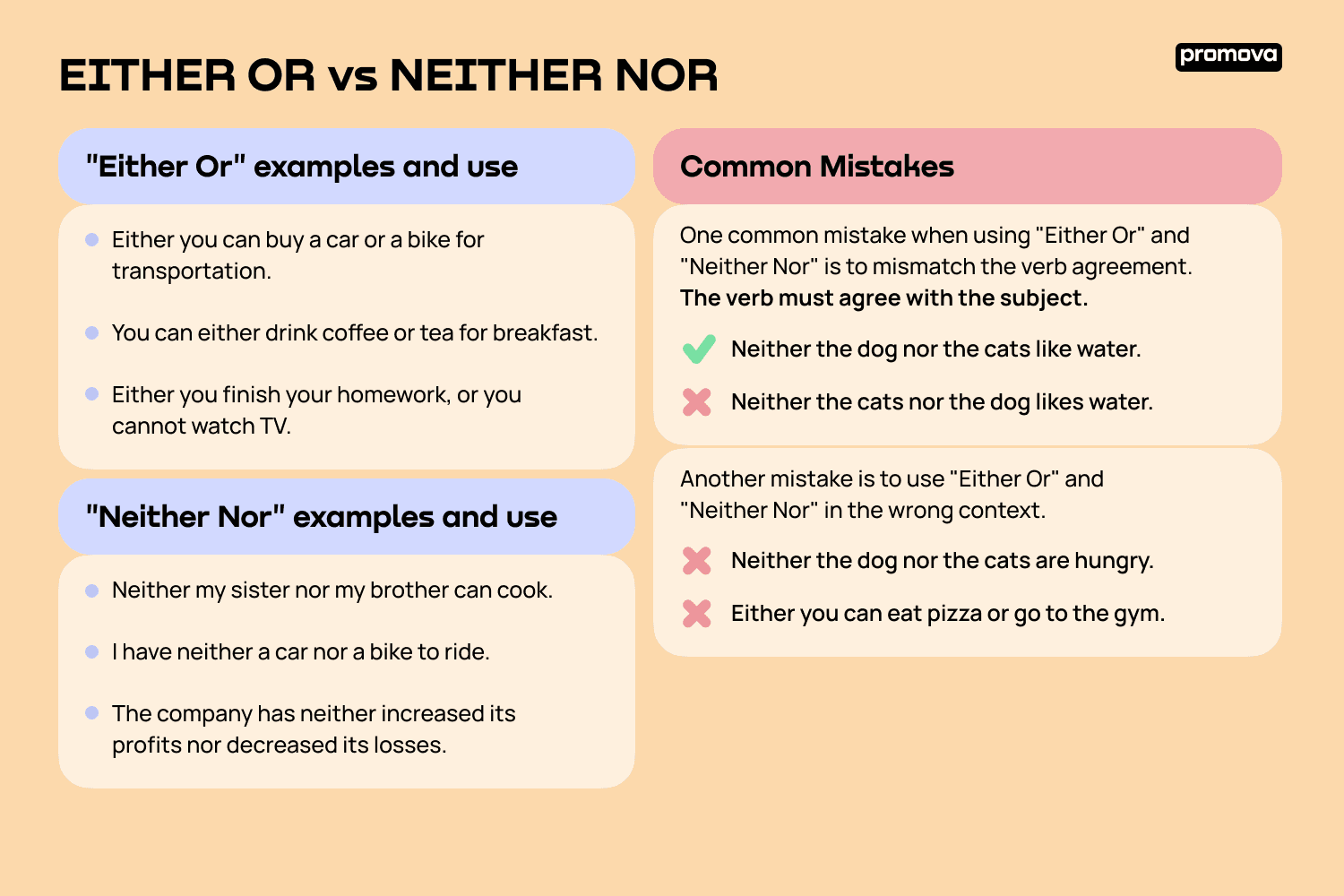EITHER OR vs NEITHER NOR
Contents
If you are learning English, you might come across the phrases "Either Or" and "Neither Nor." These phrases are widely used in English communication and can be tricky to understand at first. In this reference, we will explore the meaning of "Either Or" and "Neither Nor," their differences, and how to use them correctly.
What are Either Or and Neither Nor?
"Either Or" and "Neither Nor" are conjunctions used to connect two words, phrases, or clauses. They are used to show a choice or a negative state.
"Either Or" is used to indicate two choices, while "Neither Nor" is used to indicate negative choices.
Difference between "Either Or" and "Neither Nor"
The main difference between "Either Or" and "Neither Nor" is the type of choice they express. "Either Or" expresses a positive choice, while "Neither Nor" expresses a negative choice. Here is an example:
- Either you can come with me to the party, or you can stay at home.
- Neither John nor Peter will come to the party tonight.
In the first sentence, "Either Or" connects two positive choices, i.e., coming to the party or staying at home. In the second sentence, "Neither Nor" connects two negative choices, i.e., John and Peter will not come to the party.
"Either Or" examples and use
"Either Or" is used to express a choice between two options. Here are some more examples:
- Either you can buy a car or a bike for transportation.
- You can either drink coffee or tea for breakfast.
- Either you finish your homework, or you cannot watch TV.
In each of these sentences, "Either Or" is used to present two options, and the listener must choose one.
"Neither Nor" examples and use
"Neither Nor" is used to express a negative choice between two options. Here are some examples:
- Neither my sister nor my brother can cook.
- I have neither a car nor a bike to ride.
- The company has neither increased its profits nor decreased its losses.
In each of these sentences, "Neither Nor" is used to present two negative options, and the listener cannot choose either one.
Either Or vs Neither Nor: When to Use Each
"Either Or" and "Neither Nor" are used in different situations, and the choice between them depends on the context. Here are some guidelines:
- Use "Either Or" when presenting two positive options.
- Use "Neither Nor" when presenting two negative options.
- Use "Either Or" when presenting a positive and a negative option.
- Use "Neither Nor" when presenting two negative options that are not exclusive.
More examples:
- Either you can buy a car or save money for a trip.
- Neither the teacher nor the students were happy with the result.
- You can either study hard or fail the exam.
- Neither the movie nor the book was interesting to me.
1
Advanced Usage of "Either Or Neither Nor"
"Either Or" and "Neither Nor" can be found in more complex structures. For example:
- Either you come to the party, or I will never speak to you again.
- Neither the rain nor the snow could stop the game from happening.
- You can either be honest or lie to yourself.
In these examples, "Either Or" and "Neither Nor" are used to express the consequences of the choices made.
Common Mistakes
One common mistake when using "Either Or" and "Neither Nor" is to mismatch the verb agreement. The verb must agree with the subject. For example:
- Neither the dog nor the cats like water. (correct)
- Neither the cats nor the dog likes water. (incorrect)
Another mistake is to use "Either Or" and "Neither Nor" in the wrong context. For example:
- Neither the dog nor the cats are hungry. (incorrect)
- Either you can eat pizza or go to the gym. (incorrect)

Summary
"Either Or" and "Neither Nor" are essential conjunctions in English communication. They are used to present choices and negative options. Knowing the difference between them can improve your English language skills significantly. Remember to match the verb agreement and use the right context for each conjunction. Good luck on your learning journey!



Comments